This rare, nearly life-sized Renaissance statue by Santi Buglioni (1494—1576) is believed to represent Saint John Capistran and dates from about 1550....
This rare, nearly life-sized Renaissance statue by Santi Buglioni (1494—1576) is believed to represent Saint John Capistran and dates from about 1550. It is made of glazed terra-cotta and worked completely in-the-round. Several full-size glazed terra-cotta statues from the Renaissance are known, but most remain in the churches and sanctuaries in Tuscany for which they were originally commissioned.
Although the medium of glazed terra-cotta is familiar to us today in the form of earthenware, its adaptation for sculpture was pioneered around 1440 in Florence by Luca della Robbia. The only competitor of the della Robbia workshop was Benedetto Buglioni (1459/60—1521). According to the great Renaissance historian Giorgio Vasari, Buglioni obtained the "secret of glazing clay" from a "woman of the della Robbia household." Benedetto's nephew, Santi Buglioni, would eventually be the last remaining artist in Italy, Vasari asserted, who could create sculptures in this colorful material.
The dynamic figure is thought to represent Saint John Capistran (1420—1456), a fifteenth-century preacher whose exploits culminated in the victorious crusade against the Turks at Belgrade in 1456. He is often represented holding a banner in his left hand with the first three letters of Jesus's name in Greek, as he does in this sculpture, and wearing a Franciscan habit, which was historically brownish-gray. In LACMA's statue, however, brilliant violet takes the place of the drab neutral.
The statue is a splendid gift from The Ahmanson Foundation and a perfect complement to other works of art in LACMA's renowned collection of European sculpture. It joins the large-scale relief-figures of the Annunciation (c. 1465) by Andrea della Robbia and the grand altarpiece of the Adoration of the Shepherds (c. 1510) by Benedetto Buglioni.
More...



